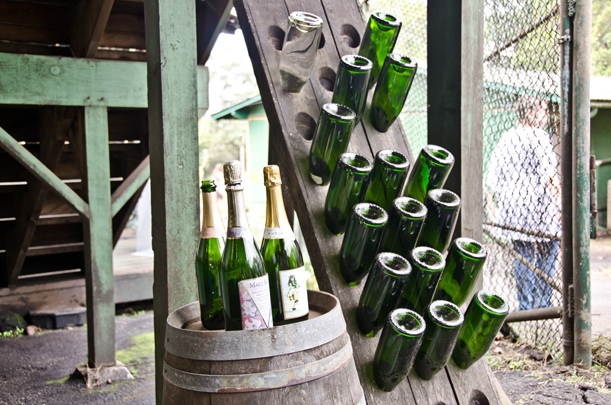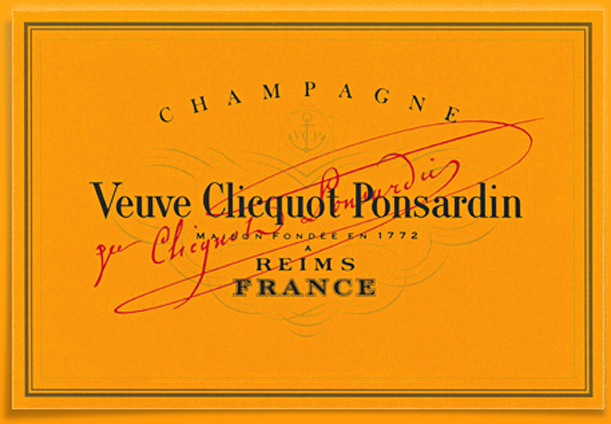The Widow Who Created the Champagne Industry
Love champagne? Thank a French widow
/https://tf-cmsv2-smithsonianmag-media.s3.amazonaws.com/filer/Food-Think-Champagne-widow.jpg)
Highlighted by its distinctive gold-yellow label, a bottle of Veuve Clicquot champagne is hard to ignore. In 2012, it was the second highest selling brand of champagne in the world, with 1,474,000 nine-liter cases sold worldwide. But Veuve Clicquot wasn’t always so successful: if it weren’t for the efforts of a cunning 19th-century business mind, the champagne might never have existed. That remarkable mind belonged to the eponymous Widow (veuve in French0) Clicquot, one of the world’s first international businesswomen, who brought her wine business back from the brink of destruction and created the modern champagne market in the process.
Do you know the story behind the veuve of Veuve Clicquot? Photo via Flicker user Wesley Vieira Fonseca.
The Widow Clicquot was born Barbe-Nicole Ponsardin, daughter of an affluent textile industrialist in Reims, France. Born in the years leading up to the French Revolution, Barbe-Nicole’s childhood was heavily influenced by the political leanings of her father, Ponce Jean Nicolas Philippe Ponsardin, which switched from monarchist to Jacobin as the tide of the Revolution turned against the monarchy. Through his shrewd politics, Barbe-Nicole’s family was able to escape the Revolution relatively unscathed, a rarity for an affluent bourgeoisie family.
Next door to Hôtel Ponsardin, the large family estate that Barbe-Nicole grew up on, lived the Clicquot family, under the patriarch Philippe. Philippe Clicquot also ran a successful textile business, making him the chief competitor to Barbe-Nicole’s father. In an attempt to consolidate the power of their two businesses, Mr. Ponsardin and Mr. Clicquot did what any shrewd business owner in the 18th century would have done: married their children. In 1798, when she was 21 years old, Barbe-Nicole married Francois Clicquot, Philippe Clicquot’s only son–the marriage was akin to an arranged marriage, a business deal devised by two industrial leaders in the small town of Reims.
Still, as the two embarked on their life together, a real partnership seemed to grow between them. Francois was a lively young man with large aspirations: instead of taking over his father’s textile industry, as his father wanted him to, Francois was interested in growing his family’s small wine business. Up to that point, the Clicquot’s family’s involvement in the wine industry constituted a minor portion of the family business. Philippe often only sold wine as an afterthought to his large textile business, adding bottles of still or sparkling white wine to orders only to round them out (once a boat had been commissioned and paid for, Philippe wanted to make sure he was getting his money’s worth). Though sparkling wine had been invented, the Champagne region was more famous for its still white wines, which Philippe would buy from wine producers and export on an as-needed basis. Philippe Clicquot had no intention of expanding its wine business to production, but Francois had a different plan.
Francois announced to his father his intention of expanding the family’s wine business, but was met with disapproval. As France plunged into the Napoleonic Wars, Philippe didn’t see wine as a profitable endeavor. Francois dismissed his father’s concerns, and set about learning the wine trade, along with his young wife. While Francois had little knowledge of wine-making, the craft ran in Barbe-Nicole’s family: one of her grandmothers had been part of a wine making operation generations earlier. Still, the two set out to learn the industry from the ground-up together.
Despite their apparent passion for the industry, Philippe Clicquot’s judgement seems to have been correct: their champagne business stalled and looked ready to collapse. In 1805, six years after their marriage, Francois fell suddenly ill with a fever; 12 days later, he was dead. Rumors swirled around the town that his death had been a suicide caused by despair at the failing business, though other accounts attribute his death to an infectious fever such as typhoid. Both Barbe-Nicole and Philippe were devastated by Francois’ death, and Philippe announced that by the end of the year, he would end the wine business.
Barbe-Nicole had other plans, and approached her father-in-law with a bold proposition.
“Barbe-Nicole goes to her father-in-law and says, ‘I’d like to risk my inheritance, I’d like you to invest the equivalent of an extra million dollars in me running this wine business.’ And he says yes,” explains Tilar Mazzeo, author of The Widow Clicquot. “It’s surprising that he would let a woman who has no business training take this on, and what it speaks to is that Philippe Clicquot was no fool. He understood how very keenly intelligent his daughter-in-law was.”
Keenly intelligent, perhaps, but at that point, Barbe-Nicole had been unsuccessful in selling champagne wine. So Philippe agreed under one condition: Barbe-Nicole would go through an apprenticeship, after which she would be able to run the business herself–if she proved her abilities. She entered into an apprenticeship with the well-known winemaker Alexandre Fourneaux, and for four years tried to make the dying wine business grow. It didn’t work, and at the end of her apprenticeship, the business was just as broke as before. So Barbe-Nicole went to her father-in-law a second time asking for money, and for a second time, Philippe Clicquot invested in his daughter-in-law’s business.
“That’s the time that comes right at the end of the Napoleonic Wars, when she has in her cellars what will become the legendary vintage of 1811, and she’s about ready to go bankrupt,” Mazzeo explains. Facing bankruptcy, Barbe-Nicole took a huge business gamble: she knew that the Russian market, as soon as the Napoleonic Wars ended, would be thirsty for the kind of champagne she was making–an extremely sweet champagne that contained nearly 300 grams of sugar (about double that of today’s sweet dessert wines, like a Sauterne). At this moment in champagne history, the champagne market was fairly small–but Russians were early enthusiasts. If she could appeal to their burgeoning desire for champagne and corner that market, Barbe-Nicole believed that success would be hers.
There was only one problem: the naval blockades that had crippled commercial shipping during the wars. Barbe-Nicole smuggled the vast majority of her best wine out of France as far as Amsterdam, where it waited for peace to be declared. As soon as peace was declared, the shipment made its way to Russia, beating her competitors by weeks. Soon after her champagne debuted in Russia, Tsar Alexander I announced that it was the only kind that he would drink. Word of his preference spread throughout the Russian court, which was essentially ground-zero for international marketing.
“She goes from being a very minor player to a name that everyone knows, and everybody wants her champagne,” Mazzeo says. Suddenly, the demand for her champagne increased so much that she was worried she would not be able to fill all the orders. Champagne making, at that time, was an incredibly tedious and wasteful business, and Barbe-Nicole realized that she would need to improve the process if she was going to keep up with the new demand for her product.
Champagne is made by adding sugar and live yeast to bottles of white wine, creating what is known as secondary fermentation. As the yeast digests the sugar, the bi-products created are alcohol and carbon dioxide, which give the wine its bubbles. There’s only one problem: when the yeast consumes all the sugar, it dies, leaving a winemaker with a sparkling bottle of wine–and dead yeast in the bottom. The dead yeast was more than unappetizing–it left the wine looking cloudy and visually unappealing. The first champagne makers dealt with this by pouring the finished product from one bottle to another in order to rid the wine of its yeast. The process was more than time-consuming and wasteful: it damaged the wine by constantly agitating the bubbles.
Barbe-Nicole knew there had to be a better way. Instead of transferring the wine from bottle to bottle to rid it of its yeast, she devised a method that kept the wine in the same bottle but consolidated the yeast by gently agitating the wine. The bottles were turned upside down and twisted, causing the yeast to gather in the neck of the bottle. This method, known as riddling, is still used by modern champagne makers.

A riddling rack, which holds the bottles at an angle and help rid them of their yeast sediments. Image via Flickr user Dave Townsend.
Barbe-Nicole’s innovation was a revolution: not only was her champagne’s quality improved, she was able to produce it much faster. Her new technique was an extreme annoyance to her competitors, especially Jean-Rémy Moët, who could not replicate her method. It wasn’t an easy secret to keep, since Barbe-Nicole employed a large number of workers in her cellars–but no one betrayed her secret, a testament to her workers loyalty, Mazzeo explains. It would be decades before any of them became wise to the method of riddling, giving Barbe-Nicole another advantage over the champagne market.
With the production of champagne increasing, Barbe-Nicole set her sights on building a global empire. By the time she died in 1866, Veuve Clicquot was exporting champagne to the far reaches of the world, from Lapland to the United States. Veuve Clicquot helped turn champagne from a beverage enjoyed solely by the upper-class to a drink available to almost anyone in the middle-upper class–a seemingly small distinction, but one that vastly increased Barbe-Nicole’s market.
“The invention of riddling allows the mass-production of an artisanal and luxury product, just not at the tiny quantities that they were dealing with before,” Mazzeo explains. “Barbe-Nicole begins exporting wine around the world in large quantities and is known as being one of the great businesswomen of her century.”
In spite of the extent of her champagne empire, Barbe-Nicole never left France during her lifetime: it would have been inappropriate for a woman to travel alone during that time. She also never remarried, though there is evidence of mild flirtations with some of her business associates (“She was rumored to have had a penchant for handsome young men working in her company,” Mazzeo explains). Had she remarried, she would almost certainly have had to relinquish control of her business, an unthinkable act for the first modern businesswoman.
From risking her inheritance on a failing business to gambling her champagne against a naval blockade, Barbe-Nicole built her champagne empire on bold decisions, a business model she never regretted. As she wrote in the later years of her life in a letter to a grandchild: “The world is in perpetual motion, and we must invent the things of tomorrow. One must go before others, be determined and exacting, and let your intelligence direct your life. Act with audacity.”
